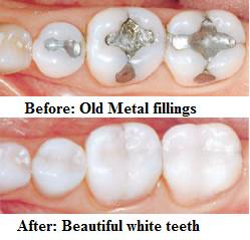What is a filling?
A filling is a way to restore a tooth damaged by decay back to its normal function and shape. When a dentist gives you a filling, he or she first removes the decayed tooth material, cleans the affected area, and then fills the cleaned out cavity with a filling material.
By closing off spaces where bacteria can enter, a filling also helps prevent further decay. Materials used for fillings include gold, porcelain, a composite resin (tooth-colored fillings), and an amalgam (an alloy of mercury, silver, copper, tin and sometimes zinc).
Type of filling
No one type of filling is best for everyone. What’s right for you will be determined by the extent of the repair, whether you have allergies to certain materials, where in your mouth the filling is needed, and the cost. Considerations for different materials include:
- Gold fillings are made to order in a laboratory and then cemented into place. Gold inlays are well tolerated by gum tissues, and may last more than 20 years. For these reasons, many authorities consider gold the best filling material. However, it is often the most expensive choice and requires multiple visits.
- Amalgam (silver) fillings advantage is that they are inexpensive; their preparation is simpler and faster than that of aesthetic fillings. The disadvantage is that it conduct heat and electricity resistant to wear. However, due to their dark color, they are less aesthetic they are more noticeable than porcelain or composite restorations and are not usually used in very visible areas, such as front teeth.
- Composite fillings are matched to be the same color as your teeth and therefore used where a natural appearance is desired. For aesthetic fillings dentists use a composite that binds when exposed to light. They can be used both for molars and teeth in the front. These materials allow us to reproduce the tooth’s original form and color as well. Contrary to traditional procedures, only a minimal amount of healthy tissue has to be removed when shaping the cavity to provide the filling with sufficient stability.
- Porcelain fillings are called inlays or onlays and are produced to order in a lab and then bonded to the tooth. They can be matched to the color of the tooth and resist staining. A porcelain restoration generally covers most of the tooth. Their cost is similar to gold.
If decay or a fracture has damaged a large portion of the tooth, a crown, or cap, may be recommended. Decay that has reached the nerve may be treated in two ways: through root canal therapy (in which nerve damaged nerve is removed) or through a procedure called pulp capping (which attempts to keep the nerve alive).

